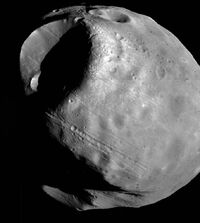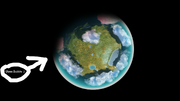
A mosaic of three separate images taken by Viking 1 on October 19, 1978. The large crater (mostly in darkness) on the upper left is Stickney.
Phobos is the largest and the closest of the two Martian moons. It orbits above the Martian surface at an altitude of 9,377 km (5,823 mi).
Physical characteristics
Phobos is one of the least-reflective bodies in the solar system. Spectroscopically it appears to be similar to the D-type asteroids,[1] and is apparently of composition similar to carbonaceous chondrite material.[2] Phobos' density is too low to be solid rock, however, and it is known to have significant porosity.[3][4][5] These results led to the suggestion that Phobos might contain a substantial reservoir of ice. Spectral observations indicate that the surface regolith layer lacks hydration,[6][7] but ice below the regolith is not ruled out.[8]
Colonization Process
It would be a good idea to colonize the two Martian moons before we think about colonizing or terraforming Mars. Phobos and Deimos would be the primary outposts/Space Stations before we take the next big step of terraforming Mars. We may even have to use these two captured asteroids to put water onto Mars, this would involve pulverizing the moons so their usefullness as outposts would end.
Paraterraforming Phobos?
Dome habitat structures could be built in the large craters of the moon, which would hold a pressurized atmosphere and trap heat when greenhouse gases, as well as nitrogen and oxygen, is added.

A Paraterraformed Phobos, by Master-Bit.
Phobos Space Station
For terraforming Mars and later for colonizing the red planet, we will need to bring equipment from Earth and raw materials from the Asteroid Belt and the Kuiper Belt. Shipping large amounts of cargo will be cheaper with the use of large, massive spaceships. Such ships will be at least 2 km long, too massive to directly land on Mars. Therefore, it would be more practical to build a space station on Phobos or Deimos. From here, smaller landing ships will travel to the planet surface.
Later, when the economy of Mars will be growing, there will be interplanetary trade, following the Trade Routes. The problem is that launch windows between Mars and all the other planets are not very frequent. So, ships will need to carry a significant amount of cargo and passengers when planets are aligned properly. This will also require massive ships to handle all the cargo.
Flight windows
Flight windows occur as follows:
Mercury - Mars: 101 Earth days Venus - Mars: 337 Earth days Earth - Mars: 777 Earth days (2 years and 47 days) Mars - Ceres: 1161 Earth days Mars - Jupiter: 816 Earth days Mars - Saturn: 733 Earth days Mars - Uranus: 702 Earth days Mars - Neptune: 695 Earth days.
This accounts for 6.84 interplanetary ships around an Earth years or one ship every 53 Earth days. However, being close to the Asteroid Belt, Phobos base could be a better destination for asteroid mining ships, which can come in at roughly 1000 Earth days.
Note that these flight windows are calculated for ships that don't use a gravity assist or deep space maneuvers. Except for Mercury and Venus, ships will have to wait two to three Earth years for the correct planetary alignment.
Flight windows between Mars and Phobos, between Mars and Deimos or between Phobos and Deimos occur daily. So, passengers will not have to wait too much at the Phobos station.
The Phobos base will have to handle a huge amount of traffic in short time, then, for a long time, it will be almost non-functional. Because of this, it will be more practical to bring food, oxygen and water from Mars then to produce them in closed ecosystems. On the other hand, building a large space station here will mean that a large part of the moon will not be opened for paraterraforming.
Since an interplanetary ship will come at around 53 Earth days, the Phobos base will only need one platform for interplanetary ships and a few small platforms for Mars landing ships. It will need to have the infrastructure needed to handle all passengers and all cargo in a short time, then it will remain empty until next interplanetary ship arrives.
Delta-v
The delta-v shows the amount of energy needed for a ship to travel from point A to point B. For destinations in the Martian system, we have the following values:
Mercury Space Station – Mars Phobos 22.566 Venus Space Station – Mars Phobos 12.953 Earth Space Station – Mars Phobos 8.585 Mars Phobos – Ceres Space Station 7.274 Mars Phobos – Jupiter Himalia 12.991 Mars Phobos – Saturn Helene 17.914 Mars Phobos – Uranus Perdita 17.786 Mars Phobos – Neptune Halimede 14.287 Mars Phobos – Pluto Styx 13.922 Mars Phobos – Eris low orbit 13.858 Mars Phobos – Sedna low orbit 12.539
Phobos – Mars 4.876 Phobos – Deimos 0.778 Mars – Deimos 5.377
For comparison, an Earth surface - Moon surface flight will require a delta-v of 14.466.
Moving a ship around Mars will require little energy. Because of this, it will be easy to send ships to Deimos base in case of an emergency. Landing on Mars actually requires less energy because Mars has an atmosphere. Sending a ship from Mars to Phobos also is easy, compared to Earth.
What catches the eye, is that the highest delta-v is required to send a ship from Mars to Mercury. Actually, sending a ship to Mercury orbit is not so difficult, but making a ship exit the elliptical transfer orbit into a circular orbit around Mercury is very hard.
Delta-v budgets for missions to outer destinations are lower then for Earth. Because of this, Mars will have cheaper access to minerals extracted from asteroids, moons of gas giants and the Kuiper Belt. The economy of Mars will benefit greatly from this.
References
- ↑ Template:Cite web
- ↑ Template:Cite book
- ↑ Template:Cite web
- ↑ Template:Cite web
- ↑ Busch, M. W.; et al.; 2007; Arecibo Radar Observations of Phobos and Deimos, Icarus, Vol. 196, pp. 581-584
- ↑ Murchie, S. L., Erard, S., Langevin, Y., Britt, D. T., Bibring, J. P., and Mustard, J. F., "Disk-resolved Spectral Reflectance Properties of PHOBOS from 0.3-3.2 microns: Preliminary Integrated Results from PHOBOS 2," in Abstracts of the Lunar and Planetary Science Conference, volume 22, page 943, (1991)
- ↑ Template:Cite journal
- ↑ Fanale, Fraser P., "Water regime of Phobos" (1991).